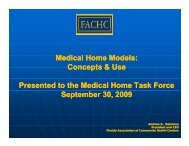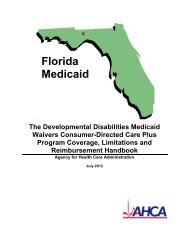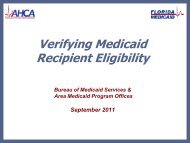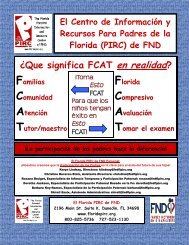Section 504 Questions and Answers Question 1: Do (1) students ...
Section 504 Questions and Answers Question 1: Do (1) students ...
Section 504 Questions and Answers Question 1: Do (1) students ...
You also want an ePaper? Increase the reach of your titles
YUMPU automatically turns print PDFs into web optimized ePapers that Google loves.
classroom. Should a teacher refuse to modify as required by the plan, the teacher is inviolation of federal law. Most school district employment contracts contain language indicatingthat the employee agrees to abide by federal <strong>and</strong> state law <strong>and</strong> local school district policy.Failing to modify as required violates that contract provision, <strong>and</strong> should result in writtendirectives, reprim<strong>and</strong>s, <strong>and</strong> more serious employment action (including nonrenewal <strong>and</strong>termination) should the employee continue to refuse to serve the child. After all, the teacher’srefusal to modify means that the district is not in compliance, <strong>and</strong> is exposed to OCRinvestigations, or <strong>504</strong> due process hearings.While the big stick of employment actions exists to convince teachers to modify, some morepractical considerations are also helpful. For example, it is an unfortunate fact that as the<strong>students</strong> moves from elementary to middle school to high school, the level of commitment toimplementing modifications among faculty tends to decrease. In all likelihood, this decline incompliance is due to the large number of <strong>students</strong> being served by an individual teacher duringthe school day, <strong>and</strong> the difficulty of keeping up with a variety <strong>students</strong> who require differentmodifications. Committees would do well to remember this simple fact when creatingaccommodation plans. Keep plans simple. Only require the use of modifications that arenecessary for the child to receive opportunity for educational benefit. That is, require only whatis necessary, not “what might be nice.” Second, make sure that classroom teachers provideinput on modifications. They are in the best position to know the requirements they are placingon <strong>students</strong>, <strong>and</strong> will also know what modifications they have seen work for the child.<strong>Question</strong> 7: How can a school ensure that modifications are being implemented in theclassroom?Nothing can replace periodic walkthroughs by administrators <strong>and</strong> watching the child’sprogress. Successful supervision requires both elements. Unannounced walkthroughs providea true (although brief) view of classroom activity. More importantly, they send the message thatat any time, an administrator could come into the classroom to observe. That reminderencourages compliance. Periodic checking of the student’s grades <strong>and</strong> behavior is alsoimportant. We want to ensure not only that the modifications are being done, but that they arethe right modifications (they are effective). By watching student performance <strong>and</strong> behavior, thecommittee can see whether the child is improving, <strong>and</strong> if not, focus its attention on what else (ifanything) should be done to modify.<strong>Question</strong> 8: <strong>Do</strong>es <strong>504</strong> contain a Least Restrictive Environment (LRE) requirement?Yes. The LRE M<strong>and</strong>ate under <strong>Section</strong> <strong>504</strong> (paraphrased from the regulations, [§104.34(a)(1)].)is to educate each qualified h<strong>and</strong>icapped person with persons who are not h<strong>and</strong>icapped to themaximum extent appropriate to the needs of the h<strong>and</strong>icapped person. The least restrictiveenvironment is defined as the setting that allows the disabled student the maximum exposureto nondisabled peers while still allowing him to receive an appropriate education. Both IDEA<strong>and</strong> <strong>504</strong> create the presumption that each disabled child can be educated in the regularclassroom. This presumption should be even stronger in <strong>504</strong> since the disabilities encounteredin <strong>504</strong> <strong>students</strong> are typically less severe. If the District believes that some setting other thanthe regular classroom is necessary for the child to receive educational benefit (meaningfulprogress on appropriate goals <strong>and</strong> objectives), the District must be ready to show that it hasprovided support services <strong>and</strong> aids to assist the child in the regular classroom, <strong>and</strong> that such
efforts have failed, before determining that a more restrictive placement is necessary. <strong>Section</strong>104.34(a).<strong>Question</strong> 9: Are there any special rules for PE & Athletics?Disabled <strong>students</strong> must be given an equal opportunity to participate in physical educationclasses, interscholastic, club <strong>and</strong> intramural athletics. <strong>Section</strong> 104.37(c)(1). “Most h<strong>and</strong>icapped<strong>students</strong> are able to participate in one or more regular physical education <strong>and</strong> athleticsactivities. For example, a student in a wheelchair can participate in a regular archery course,as can a deaf student in a wrestling course.” Appendix A, p. 431. Where a disabled studentcannot participate in the PE activities, an alternative activity, consistent with his abilities,should be provided. Separate or different physical education <strong>and</strong> athletic activities may beoffered to disabled <strong>students</strong> “only if the separation or differentiation is consistent with therequirements of [LRE] <strong>and</strong> only if no qualified h<strong>and</strong>icapped student is denied the opportunity tocompete for teams or to participate in courses that are not separate or different.” <strong>Section</strong>104.37(c)(2).With regard to interscholastic teams which utilize performance criteria in determining who willparticipate, disabled <strong>students</strong> must be given the opportunity to compete for a spot on the team.For example, parents of a student with Tourette’s Disorder claimed discrimination when thestudent was not picked for the baseball team. They alleged that the coach knew of the child’sdisability <strong>and</strong> resulting behavior problems, <strong>and</strong> discriminated against the student for thosereasons. The coach was able to demonstrate that the student failed to meet regularperformance criteria to participate on the team. Students wanting to join the team participatedin a series of drills, which the coach observed <strong>and</strong> analyzed. The coach ranked the <strong>students</strong>on a variety of performance criteria: speed, balance, coordination, h<strong>and</strong>-eye coordination,sprint speed, lateral movement, <strong>and</strong> softness catching the ball. Out of fourteen <strong>students</strong> tryingout for two openings, the claimant finished eighth, <strong>and</strong> did not receive a position on the team.OCR found no violation as the “student was given an equal opportunity to compete for aposition.” Maryville City (TN) School District, 25 IDELR 154 (OCR 1996).<strong>Question</strong> 10: Is it possible for a <strong>504</strong> program to be appropriate when the student fails a class?Yes. A problem sometimes encountered by <strong>Section</strong> <strong>504</strong> coordinators is concern over a childwho even with accommodations has failing grades. A question often asked is what do we do ifwe know the accommodation plan is appropriate <strong>and</strong> is being implemented in the classroom<strong>and</strong> the child still fails? As the following cases demonstrate, school officials need to be able toarticulate <strong>and</strong> demonstrate the reason for the failure. Presumably, the reason cannot arisefrom disability unless it has been accommodated, <strong>and</strong> the student rejects the accommodation.A disabled student fails because he didn’t turn in work—he didn’t try. The parent complains toOCR that the student’s IEP has not been implemented causing the student to fail inkeyboarding <strong>and</strong> Spanish class. The student is learning disabled. Classroom modificationsincluded extra time for written work, the chance to redo work deemed unacceptable by theteacher, <strong>and</strong> verbal clarification of instructions <strong>and</strong> assignments. The student failed
keyboarding when he failed to complete, print, or turn in work. In the Spanish class (where noaccommodations were required) the student nose-dived after the third 9-week session whenhe failed to make up three tests, a vocabulary poster <strong>and</strong> a major composition. The student lefthis final exam blank. When given the opportunity to redo papers or make corrections onassignments for a new grade (something the teacher did for all <strong>students</strong>), the student chosenot to participate. OCR finds no violation. “Student B’s failure to pass keyboarding <strong>and</strong> Spanishwas not related to the District not implementing his IEP. The District tired [sic] to implement hisIEP, however, the student would not attend make up or tutoring sessions <strong>and</strong> did not retakeexams when the opportunity was available.” Beaufort County (SC) School District, 29 IDELR75 (OCR 1998). See also, Spartanburg #4 (SC) School District, 29 IDELR 252 (OCR 1998).An important lesson emphasized by this case is that disability is but one potential contributingfactor in a child’s ability to perform at school. Another important factor in these two cases is thedistricts’ good faith <strong>and</strong> clean h<strong>and</strong>s. In these cases, there was no question that school officialswere concerned for the child <strong>and</strong> his performance. There was also a level of extra attention<strong>and</strong> effort in each case, <strong>and</strong> procedural compliance. Since OCR will typically not second-guesseducational decisions made following the proper procedures, <strong>and</strong> the good faith of the schoolofficials deflected any other concerns, the districts were found in compliance.<strong>Question</strong> 11: Who bears the responsibility for implementing the <strong>504</strong> plan <strong>and</strong> for providing afree appropriate public education (FAPE)?While parents <strong>and</strong> the public schools are often referred to as partners in education, theultimate legal responsibility for FAPE under <strong>Section</strong> <strong>504</strong> rests with the school. 34 C.F.R.<strong>Section</strong> 104.33(a).<strong>Question</strong> 12: Can a principal or other administrator veto a <strong>504</strong> Committee decision because itis too expensive, even if the modification is necessary for a free appropriate public education?No. The <strong>Section</strong> <strong>504</strong> regulations require that decisions about a child's educational placementbe made a "group of knowledgeable people" which we refer to as the "<strong>504</strong> Committee."Inherent in that requirement is the prohibition on a single person making the placementdecision instead of the required group, <strong>and</strong> a prohibition on a single person overruling the <strong>504</strong>Committee. That being said, a principal or other administrator's concerns about the cost of aprogram cannot be overlooked (especially when Committee members are subject toemployment actions by the principal). Cost can certainly be a factor, but the regulations do notallow a district to omit a modification required for FAPE simply because it is costly. Unlike theADA's application in the employment context, there is no "reasonable accommodation"requirement under <strong>Section</strong> <strong>504</strong> for the public schools when FAPE is at issue. OCR Responseto Zirkel, June 28 ,1993. So, if an expensive modification is needed, the sheer cost does notmean that the modification can be rejected by the Committee. Note that, just like in specialeducation, a more expensive modification isnever required when a less expensive alternative is also appropriate.Of course, should expensive programming or services be required to provide a student withFAPE, the Committee should consider whether <strong>504</strong> is the appropriate program to provideservices. After all, <strong>504</strong> <strong>students</strong> are generally educable in the regular classroom with fairlyroutine <strong>and</strong> inexpensive modifications. If more serious programming or services are required(resource classes, a one-on-one aide, occupational therapy, physical therapy, speech, etc.)
the Committee should consider whether special education eligibility is possible, thus openingup the resources of the IDEA for the child.<strong>Question</strong> 13: Can a <strong>504</strong> Committee change a student's grade?No. A student's grade ought to be the teacher's determination of the child'sprogress/performance in the class. A child's grade is not a free appropriate public education(FAPE) issue, that is, the right to a free appropriate public education (<strong>and</strong> the resulting right toopportunity for educational benefit) is not tied to the grade, but to the student's progress. Sincethe grade itself is not a FAPE issue, it is not controlled by the <strong>504</strong> Committee.However, if, for example, the teacher has failed to implement required modifications for anexam, <strong>and</strong> a child fails the exam, the <strong>504</strong> Committee has the authority to order the teacher tore-test with the required modifications. As a result, the student gets the modifications that wererequired <strong>and</strong> the proper grade can be determined. Resist the urge as a <strong>504</strong> Committee tosimply replace a teacher's grade with what you think the student would have received had thestudent received the proper modifications.<strong>Question</strong> 14: When a <strong>504</strong> student moves into the district with an existing <strong>504</strong> plan, what is thenew district's duty?When a <strong>504</strong> student moves into a new school district, is eligible to attend <strong>and</strong> enrolls, the newdistrict is obligated to provide a free appropriate public education (FAPE). That may prove a bitdifficult since the new district has no experience with the student. The safe course is toreplicate the student's services received in the previous district while the new district’spersonnel gain experience with the child.After a few weeks, the new district should conduct a <strong>504</strong> reevaluation <strong>and</strong> make changes tothe accommodation plan as necessary. If the student's program from the former district cannotbe replicated in your district, approximate it as closely as you can, <strong>and</strong> during the evaluationprocess, pay special attention to the student's needs that were met by that portion of the planwhich you could not duplicate. TheCommittee may find that other programs or services might meet the need.<strong>Question</strong> 15: Can the <strong>504</strong> Committee order accommodations to the ACT/SAT?Not with any real authority. The Educational Testing Service (ETS) will review themodifications a student is receiving under <strong>504</strong> or IDEA when it makes its own independentdetermination of whether modifications to college entrance exams will be allowed.Underst<strong>and</strong>ably, a student who receives modified testing in the school setting seems a morelikely c<strong>and</strong>idate to receive modifications on college entrance exams. Likewise, the longer thestudent has received the modifications, the more likely they will be considered favorably. Asmight be expected, a few juniors <strong>and</strong> seniors claim disability each year for the sole purpose ofreceiving extra time on these critical exams. The independent review by ETS apparently iscalculated to prevent that abuse.<strong>Question</strong> 16: What is the school district’s duty to transport <strong>students</strong> under §<strong>504</strong>?With respect to transportation, the district’s duty to <strong>504</strong> <strong>students</strong> is two fold. First, is the basic<strong>504</strong> nondiscrimination duty. Simply stated, a disabled student should not be denied access to
transportation a similarly situated nondisabled student can access. In other words, a <strong>students</strong>hould not be denied transportation for which he is otherwise eligible because he is disabled. Ifthe district provides transportation to <strong>students</strong> who live a certain distance from the school orwho must cross a dangerous road to get to school, that service must be offered equally todisabled <strong>and</strong> nondisabled <strong>students</strong> who meet the eligibility criteria.Second, even if transportation services are not available to a population of <strong>students</strong> (becausethey live too close to school, for example), a disabled child’s physical or mental impairmentmay require the district to provide transportation services so that the disabled child can accesseducation at the school. “Under <strong>Section</strong> <strong>504</strong>, a recipient is required to offer transportationservices in such a manner as is necessary to afford <strong>students</strong> with disabilities an equalopportunity for participation in such services <strong>and</strong> activities.” Whitman-Hanson (Ma) RegionalSch. Dist., 20 IDELR 775, 779 (OCR 1993). For example, a student whose asthma isaggravated by certain climates/seasons may be unable to walk to school during certain timesof the year without experiencing severe breathing problems. Similarly, a student who used tobe able to walk to school but cannot do so now (due to broken leg or similar mobilityimpairment) may require transportation to school as a <strong>504</strong> accommodation. Note that in neithercase would a special bus be required (unless the mobility impairment resulted in the temporaryuse of a wheelchair). Giving both <strong>students</strong> access to the regular bus (which they could notaccess earlier due to the short distance to school) is an appropriate accommodation.<strong>Question</strong> 17: Is a District required to provide transportation under <strong>504</strong> for <strong>students</strong> in private orhomeschools?Typically No. In 1998, parents of a student unilaterally placed in a homeschool by the parentscomplained to OCR that the district refused to provide transportation to the student for a onehour class in the district each day. In its rejection of the parent’s complaint, OCR reiterated therule.“Under the <strong>Section</strong> <strong>504</strong> regulation, a recipient may be required to provide transportationservices or the costs of those services to get a qualified student with a disability to <strong>and</strong> fromschool in the District; the District may also be required to get a qualified student with adisability to or from a program other than its own, when the recipient places the student in theprogram.... However, if a recipient offers a free appropriate educational program to a studentwith a disability, <strong>and</strong> the parent chooses to place the student in an alternative educationalplacement, the recipient has no obligation under the <strong>Section</strong> <strong>504</strong> <strong>and</strong> ADA regulations toprovide transportation services for the student to attend a program or class at a school, evenwithin the district, except to the extent it provides such services to similarly situated <strong>students</strong>without disabilities (i.e., to <strong>students</strong> without disabilities whose principal educational placementis not with, or sponsored by, the recipient).” Spencer County (Ky) Sch. Dist., 31 IDELR 38(OCR 1998).Since the District did not provide transportation services to nondisabled <strong>students</strong> who attendedprivate or homeschools, OCR found no obligation to do so for a similarly situated <strong>504</strong> student.See also, Westhampton Beach (NY) Union Free Sch. Dist., 28 IDELR 996 (OCR 1998)(Bypolicy the district provides transportation to children attending nonpublic schools within 15miles <strong>and</strong> on currently existing district routes. Parent submitted request after the requireddeadline, for a school outside the 15 mile limit <strong>and</strong> not on a current route. OCR finds noviolation for the district’s refusal to transport the student.)
<strong>Question</strong> 18: Can a <strong>504</strong> student ride a special ed bus if regular transportation is notappropriate (that is, the student needs a monitor or alift)?Yes. But strings attach. The Office for Special Education Programs has concluded that inlimited circumstances, it is possible for a non-IDEA qualifying child to access an IDEA-Bfunded school bus. The question arose from a situation in Nebraska where the state desired totransport Head Start <strong>students</strong> together with Early Childhood Special Education <strong>students</strong> on thesame IDEA-B funded buses. OSEP concluded that the arrangement “would be permissiblewithout a cost allocation from other funding sources only under very strict circumstances. First,the vehicle would have to make the same trip <strong>and</strong> incur the same expense whether or not theHead Start children were also riding. Secondly, the Head Start children could not displace achild with disabilities from the vehicle.” Letter to Lutjeharms, 20 IDELR 180 (OSEP 1993).Finally, the district can’t get tricky <strong>and</strong> use IDEA-B funds “to purchase or operate vehicles thatare too large for the intended purpose of providing transportation to children with disabilities inorder to provide seating capacity on those vehicles for non-disabled children, thereby avoidingcost allocations from other sources of funds.” Id.<strong>Question</strong> 19: <strong>Do</strong>es LRE (the least restrictive environment requirement) apply to transportation?Yes. The regulations prohibit the district from providing different or separate aids, benefits orservices unless such action is necessary to provide qualified disabled <strong>students</strong> with aids,benefits <strong>and</strong> services that are as effective as those provided to nondisabled <strong>students</strong>.§104.4(b)(1)(iv). Further, <strong>students</strong> with disabilities must be educated with nondisabled <strong>students</strong>to the maximum extent appropriate to the needs of the disabled student. §104.34. In otherwords, when the <strong>students</strong>’ transportation needs can be met on the regular education bus, thestudent should not be placed on the special education bus simply because he or she isdisabled. Kenai Peninsula (Ak) Borough Sch. Dist., 20 IDELR 673 (OCR 1993).













